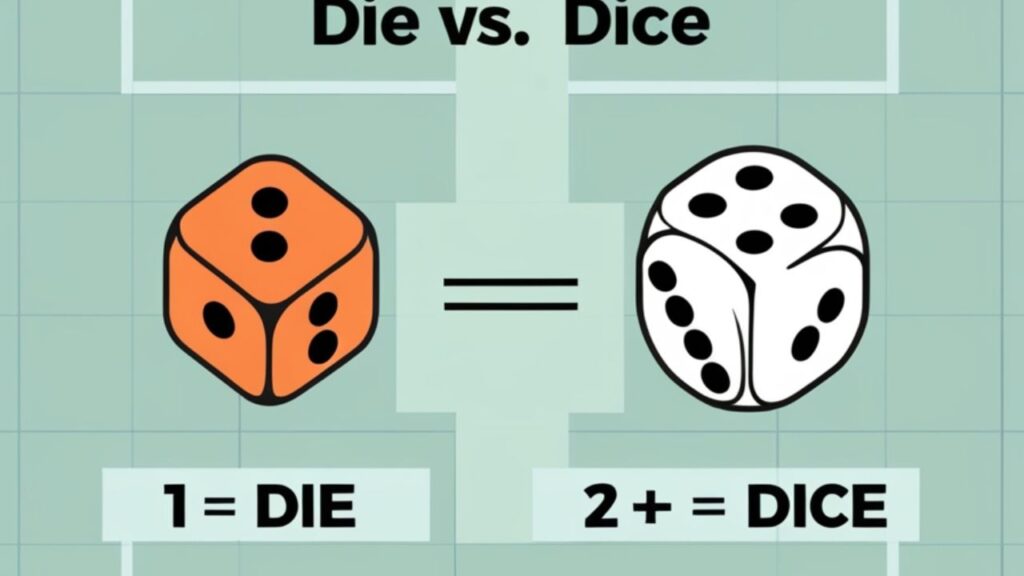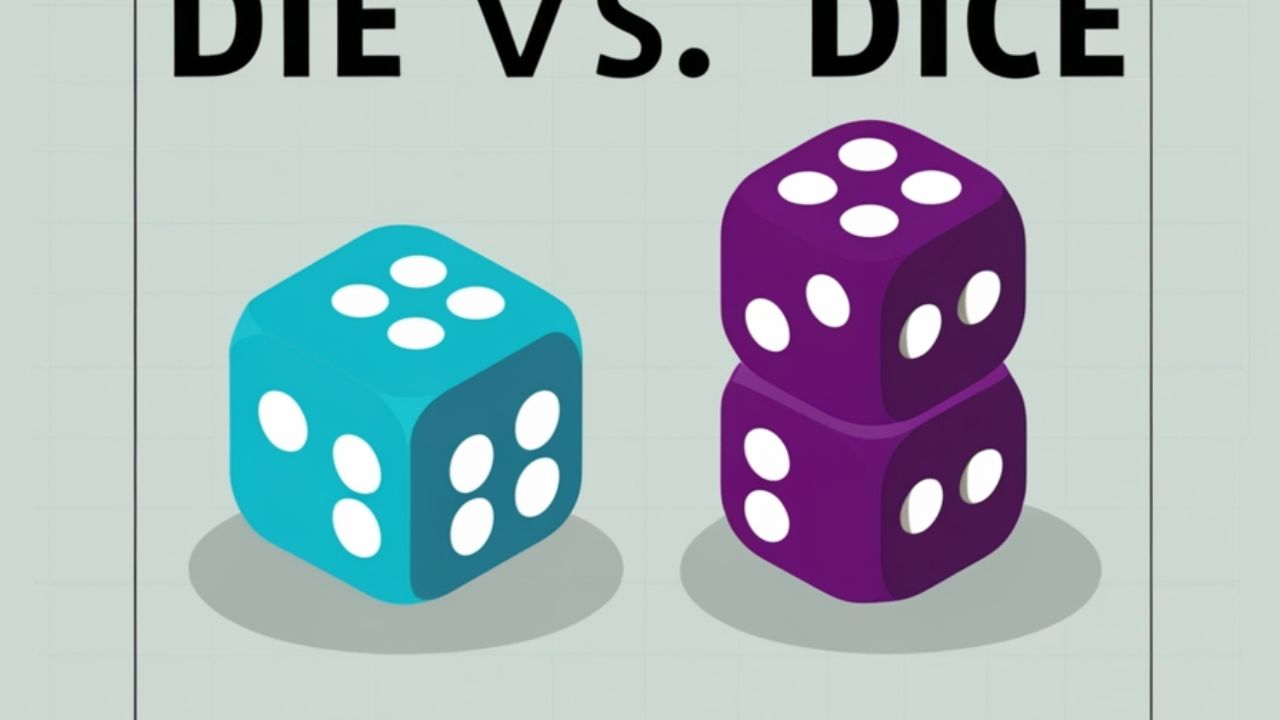Children often play games that use small cubes with numbers. Each cube is called a die, and more than one is called dice. This tiny word difference matters. It helps children learn how words change when we talk about one or many things.
In games, one die decides a single move, while two dice make things more exciting. Teachers use these cubes to teach counting, adding, and even fair play. Knowing the right word builds confidence in speaking and writing clearly.
Over time, people began saying dice for both one and many cubes. Dictionaries now accept this in daily talk. Still, learning the traditional forms helps young learners write better and understand how language changes over time.
Understanding the Core Difference Between ‘Die’ and ‘Dice’
The word die means one small cube used in games. When you have more than one, you call them dice. This rule helps young learners know how English changes when something is single or many. It makes speaking and writing clearer.
Each die has numbers from one to six. When children play with dice, they learn counting and simple math. Teachers also use them for fun lessons. Understanding this rule builds better grammar habits and helps children feel confident while learning new words.
| Term | Traditional Usage | Modern Informal Usage | Example |
| Die | Singular | Less common | “Roll one die.” |
| Dice | Plural | Singular & Plural | “Roll the dice.” |
Etymology and Origin of ‘Die’ and ‘Dice’
The word die comes from Old French “dé,” which meant a small playing cube. Long ago, it came from Latin “datum,” meaning “something given.” This shows how languages change over time, turning old words into ones we still use today.
The word dice grew from the same root as die. People began using it when talking about more than one cube. Over many years, the words became part of games and learning. Their origin reminds us how history shapes the way we speak.
Grammatical Evolution: Singular vs. Plural Rules

- Use die for one cube. Use dice for more than one. Teachers model this rule in class.
- Writers kept die as singular for many years. People later used dice for one in casual talk.
- Dictionaries record both patterns now. Formal grammar still prefers die for one and dice for many.
- Game rules use clear forms. Write “roll one die” for a single cube. Write “roll two dice” for several.
- Teach consistency first. Explain the history after practice. Students learn faster with charts examples and short sentences.
See also : Invaluable vs Valuable: Key Differences Explained Simply
Modern English Usage and Acceptance in Dictionaries
- Many speakers use dice for one and many. Teachers still teach die for one in formal work. Writers choose the form that fits the audience.
- Big guides like Oxford and Merriam-Webster record both uses. They explain the change in simple notes.
- Schools prefer the older rule in exams. Lessons say die for one and dice for more. This keeps writing clear.
- Game books keep the rule strict. They write “roll one die” and “roll two dice.” Children learn fast with steady rules.
- Dictionaries allow flexible usage outside class. You choose the form that helps readers. Teachers ask for consistency in homework.
Practical Usage: How ‘Die’ and ‘Dice’ Appear in Real Life
| Context | Preferred Term | Example |
| Board Games | Die/Dice | “Roll one die.” / “Roll two dice.” |
| Casinos | Dice | “Place your dice on the table.” |
| Casual Speech | Dice | “Let’s roll the dice.” |
Children often use a die or dice while playing games at home or school. In these games, one die helps decide turns or moves. Teachers also use them during lessons to teach numbers, colors, and counting in a fun, clear way.
At fairs and family gatherings, people roll dice for fun and luck. In math class, they help show how numbers can change each time you roll. These small cubes make learning exciting and help children enjoy both play and study.
Regional and Cultural Variations in Usage
- In the United States, many speakers use dice for one and many. Schools still teach die for one in careful writing. Children hear both forms in games and shows, so teachers give clear examples.
- In the United Kingdom, writers keep the older rule more often. They say die for one and dice for more. Class books and exams follow this pattern to keep usage steady.
- Gaming groups shape habits. Casino workers usually say dice at the table. Board-game clubs teach “roll one die” during setup. Children copy the form they hear during play.
- Language classes guide learners gently. ESL teachers explain the rule first. They add local notes later. Students practice with charts that show die for one and dice for many.
- Online communities mix styles. Streamers and bloggers choose forms that fit their audience. Some prefer strict rules. Others follow everyday usage for quick reading. Kids learn both, then choose based on context.
Common Mistakes and Misunderstandings
Many learners mix up die and dice while speaking or writing. They often say “a dice” instead of “a die.” This small mistake happens because people hear it often in games or daily talk, where grammar rules feel less important.
Sometimes, children also confuse die with the word that means “to stop living.” To avoid misunderstanding, teachers explain through games or examples. Using charts and practice sheets helps students remember which word fits best in each situation.
| Incorrect Usage | Correct Usage | Explanation |
| “He rolled a dice.” | “He rolled a die.” | “Die” is the singular form. |
| “She has two die.” | “She has two dice.” | “Dice” is the plural form. |
Idioms, Metaphors, and Expressions Using ‘Die’ or ‘Dice’
- “The die is cast” means the choice is final. You move forward and accept the result. Teachers use it when a test starts and pencils go down. The phrase helps children understand commitment and calm decision-making.
- “Roll the dice” means take a small risk. Players accept surprise results and learn courage. In class, a teacher may say it before a guessing game. The idea builds confidence and healthy excitement during learning activities.
- “No dice” means no agreement. Someone tried, but the answer stays no. Parents use it to set clear limits. Children learn polite refusal and respect for rules. The phrase keeps conversations short, firm, and kind.
- “Loaded dice” describes unfair advantage. One side controls the result. Coaches use it to explain cheating and why fairness matters. Children see that games need trust and equal chances. The phrase supports honest play and teamwork.
- “A dicey situation” means a risky moment. You step carefully and think first. Teachers use it for safety talks during trips or sports. Children learn to pause, look around, and choose actions that keep everyone protected.
Expert Opinions and Case Studies

Language experts note that die and dice have changed meaning with time. Many writers and teachers support using both forms based on context. They guide learners to follow the traditional rule in formal writing and accept modern speech differences in casual use.
In schools and grammar studies, case reviews show students remember die and dice better through practice games. Educators found visual aids and storytelling improve understanding. These real examples help children learn how proper word choice keeps English clear and correct.
- Language teachers recommend using die for one and dice for many. They track errors in notebooks. Their notes show steady progress when students practice daily grammar drills with short lines and clear charts.
- School studies compare classes that play games with classes that only read rules. The game groups remember die and dice better. Researchers highlight repetition and usage in real play as the winning method.
- Editors review rulebooks from major board games. Most books write “roll one die” and “roll two dice.” This model gives a firm guide. Students copy the layout and improve grammar accuracy.
- ESL programs test beginner learners. Teachers show a cube then speak the word. Students roll once for die then roll twice for dice. Case notes report faster recall with hands-on usage.
- Dictionary teams publish updates and examples. They accept informal usage where people say dice for one in speech. Classroom guides still teach the traditional rule. This balance keeps writing neat and supports clear grammar.
SEO Comparison: How People Search for ‘Die vs. Dice’
- Many learners type die vs. dice in search bars. They want quick rules and short examples. Guides that show a table, a chart, and one clear sentence rank well for SEO and help readers finish in seconds.
- People also search die singular and dice plural. They need simple confirmation. Pages that give a bold rule, two samples, and one line of usage advice often win the snippet and bring steady clicks.
- Students look for grammar worksheets and mini quizzes. They prefer printable PDFs and tiny drills. Sites that add a one-page practice sheet and a clear answer key gain longer visits and better engagement.
- Teachers search board game rules with wording help. They want classroom-ready lines like “roll one die.” Pages that include a ready list, a poster image, and a short script improve usability and share rates.
- Parents try voice search for quick tips. Short lines and clean headings support mobile results. Pages that show a summary table, a 30-second explanation, and two example sentences earn higher readability and return visits.
See also : Content vs Contented: Key Meanings and Usage Tips
Final Guidelines for Correct Usage in Your Writing
Use die for one cube. Use dice for more than one. Follow this in tests, homework, and rule sheets. Write short clear sentences. Check that nouns and verbs match in number. Choose simple words. Keep examples from games to make meaning obvious.
When you teach or write, show the form before practice. Say the word, then use it in a line. Review after games. Correct gently. Build a small chart for die and dice. Repeat daily. Give stars for careful grammar.
| Number of Cubes | Formal Writing | Informal Writing |
| One | Die | Dice |
| Two or more | Dice | Dice |
Summary Table: ‘Die’ vs. ‘Dice’ at a Glance
| Term | Function | Number | Common Contexts | Example Sentence |
| Die | Noun | Singular | Board games, formal writing | “Roll one die.” |
| Dice | Noun | Plural/Singular | Casinos, informal speech | “Roll the dice.” |
Final Thoughts
These final notes help you use the words well. Learn the difference between die and dice. Practice it in class and at home. Use clear grammar in every line. Write simple examples from games. Build steady habits that guide your writing.
You grow stronger when you repeat the rule daily. Say the forms aloud. Roll a cube and write one line with die. Roll two cubes and write one line with dice. Keep a small chart. Share work proudly with grammar stars.
FAQs
Is invaluable a good thing?
Yes, “invaluable” is a good thing. It means something is so precious or useful that it’s beyond measurable value.
What does “invaluable” mean?
“Invaluable” means extremely useful or priceless — something so valuable that its worth cannot be calculated.
Why do people say invaluable?
People say “invaluable” to emphasize extreme importance or worth that goes beyond money or measurable value.
Is invaluable a contronym?
No, “invaluable” isn’t a contronym. Despite sounding negative, it only means “extremely valuable,” not “without value.”

Join Bibcia on a journey to master English grammar. Discover easy lessons, writing tips, and practical examples designed to make learning grammar simple and effective.










